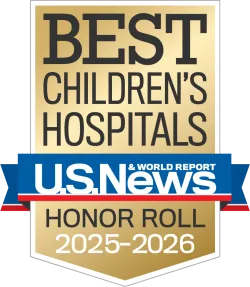Breadcrumb
- Home
- Conditions & Treatments
- Luxturna
What is Luxturna®?
Luxturna® (voretigene neparvovec-rzyl) is a one-time gene therapy treatment for inherited retinal disorders caused by mutations in the RPE65 gene. It is injected directly into the eye by specialists in the Department of Ophthalmology at Boston Children’s Hospital, a certified Center of Excellence for Luxturna treatment.
Your child may be eligible for Luxturna if they have a diagnosis of retinal dystrophy, Leber congenital amaurosis (LCA), or retinitis pigmentosa (RP).
Who is eligible to receive Luxturna?
Luxturna was approved by the Food and Drug Administration (FDA) in 2017 for patients over 12 months old who have variants in both copies of the RPE65 gene. To qualify for the treatment, your child must have enough remaining healthy cells in the retina to be able to respond (your doctors can confirm this).
How does Luxturna work?
Luxturna delivers a working copy of the RPE65 gene to the retina (the light-sensitive tissue at the back of the eye). This healthy copy helps restore the visual cycle, a series of chemical reactions in the retina in response to light — and the first step in our ability to see. RPE65 provides instructions for making a key enzyme in this cycle.

Does Luxturna cure blindness?
While Luxturna doesn’t cure blindness, studies have found improved vision in most people with significant vision loss. The study that led to the FDA approval showed that people receiving Luxturna were more able to complete an obstacle course in low light conditions.
What is involved in Luxturna gene therapy?
A delivery vehicle or “vector” carrying Luxturna is injected directly into the eye, beneath the retina, by a surgeon in one of our outpatient operating rooms. Your child will start taking oral steroids before the injection and continue for some time after the injection.
The injections will happen one eye at a time, on two different dates separated by at least six days. Each injection procedure will take several hours and doesn’t typically require an overnight hospital stay.
After each injection, we will have your child come for clinic visits to examine their eyes, measure their vision, and check for any side effects of the treatment. The first visit is typically a week after the injection, with additional visits one month and five months later. If you live far from Boston, talk with your doctor about arrangements for staying in the area. You may also be asked to return for additional eye exams one year after treatment.
Is Luxturna a one-time treatment?
Yes, Luxturna needs to be given just once to each eye. Each eye is treated separately, in two separate visits at least six days apart.
Is Luxturna safe?
Luxturna has been generally found to be safe. About one in 20 people may experience side effects, most commonly redness of the eye (due to increased blood supply), eye swelling or pain, clouding of the lens of the eye (cataract), and increased pressure inside the eye.
Less common side effects include eye infections, breaks or other changes in the retina, and loss of visual acuity. These are uncommon, but it’s important to return for follow-up visits to identify and treat any side effects.
How much is Luxturna out of pocket?
Because Luxturna is so new, it’s not yet clear to what extent health insurance providers will cover this therapy. We encourage you to talk with your health insurance company and care team. The Financial Services staff at Boston Children’s can guide you through the insurance approval process.
Questions?
Contact Hanna De Bruyn, Retinal Gene Therapy Coordinator.
- Phone: 617-919-3042
- Email: hanna.debruyn@childrens.harvard.edu


